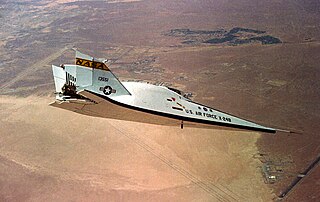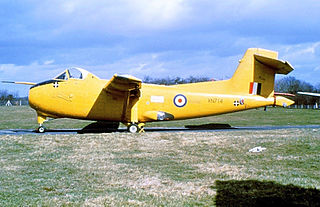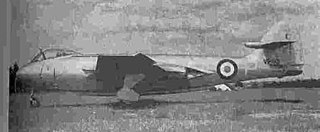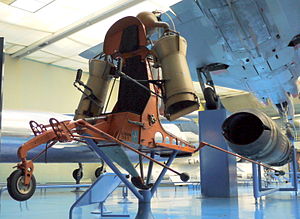Air-augmented rockets use the supersonic exhaust of some kind of rocket engine to further compress air collected by ram effect during flight to use as additional working mass, leading to greater effective thrust for any given amount of fuel than either the rocket or a ramjet alone.

The Martin Marietta X-24 was an American experimental aircraft developed from a joint United States Air Force-NASA program named PILOT (1963–1975). It was designed and built to test lifting body concepts, experimenting with the concept of unpowered reentry and landing, later used by the Space Shuttle. Originally built as the X-24A, the aircraft was later rebuilt as the X-24B.

A rocket engine uses stored rocket propellant mass for forming its high-speed propulsive jet. Rocket engines are reaction engines, obtaining thrust in accordance with Newton's third law. Most rocket engines use combustion, although non-combusting forms also exist. Vehicles propelled by rocket engines are commonly called rockets. Since they need no external material to form their jet, rocket engines can perform in a vacuum and thus can be used to propel spacecraft and ballistic missiles.

The Mikoyan-Gurevich I-250 was a Soviet fighter aircraft developed as part of a crash program in 1944 to develop a high-performance fighter to counter German turbojet-powered aircraft such as the Messerschmitt Me 262. The Mikoyan-Gurevich design bureau decided to focus on a design that used something more mature than the jet engine, which was still at an experimental stage in the Soviet Union, and chose a mixed-power solution with the VRDK motorjet powered by the Klimov VK-107 V12 engine. While quite successful when it worked, with a maximum speed of 820 km/h (510 mph) being reached during trials, production problems with the VRDK fatally delayed the program and it was canceled in 1948 as obsolete.

The DFS 346 was a German rocket-powered swept-wing aircraft which began development during World War II in Germany. It was designed by Felix Kracht at the Deutsche Forschungsanstalt für Segelflug (DFS), the "German Institute for Sailplane Flight". A prototype was constructed but did not reach completion before the end of the war. It was taken to the Soviet Union where it was completed, tested and flown.

The Yakovlev Yak-38 was the Soviet Naval Aviation's only operational VTOL strike fighter aircraft in addition to being its first operational carrier-based fixed-wing aircraft. It was developed specifically for, and served almost exclusively on, the Kiev-class aircraft carriers.

A jet pack, rocket belt, or rocket pack is a device worn on the back which uses jets of gas or liquid to propel the wearer through the air. The concept has been present in science fiction for almost a century and became widespread in the 1960s. Real jet packs have been developed using a variety of mechanisms, but their uses are much more limited than their fictional counterparts because of the challenges of Earth's atmosphere, gravity, low energy density of available fuels, and the human body not being suited to fly, and they are principally used for stunts. A practical use for the jet pack has been in extra-vehicular activities for astronauts.

The Yakovlev Yak-141, also known as the Yak-41, is a Soviet supersonic vertical takeoff/landing (VTOL) fighter aircraft designed by Yakovlev. It was used for testing.

The Yakovlev Yak-36, also known as Izdeliye V, is a Soviet technology demonstrator for a VTOL combat aircraft.
The Grumman G-118 was a design for an all-weather missile-armed interceptor aircraft for use on US Navy aircraft carriers. Originally conceived as an uprated F11F Tiger, it soon evolved into a larger and more powerful project. Although two prototypes were ordered in 1955, development was cancelled the same year in favor of the F4H Phantom II before any examples were built. Grumman's next carrier fighter would be the F-14 Tomcat, ordered in 1968.

The Ryan XV-5 Vertifan was a jet-powered V/STOL experimental aircraft in the 1960s. The United States Army commissioned the Ryan VZ-11-RY in 1961, along with the Lockheed VZ-10 Hummingbird.

The Lockheed XV-4 Hummingbird was a U.S. Army project to demonstrate the feasibility of using VTOL for a surveillance aircraft carrying target-acquisition and sensory equipment. It was designed and built by the Lockheed Corporation in the 1960s, one of many attempts to produce a V/STOL vertical take off/landing jet. Both prototype aircraft were destroyed in accidents.

The Rockwell XFV-12 was a prototype supersonic United States Navy fighter which was built in 1977. The XFV-12 design attempted to combine the Mach 2 speed and AIM-7 Sparrow armament of the McDonnell Douglas F-4 Phantom II in a VTOL fighter for the small Sea Control Ship which was under study at the time. On paper, it looked superior to the subsonic Hawker Siddeley Harrier attack fighter. However, it proved unable to produce enough thrust for vertical flight, even with an installed engine delivering more thrust than its empty weight, and the project was abandoned.

The Bereznyak-Isayev BI-1 was a Soviet short-range rocket powered interceptor developed during the Second World War.

The Hunting H.126 was a British experimental aircraft designed and built by Hunting Aircraft in order to test the concept of blown flaps, or as they were known in Britain, "jet flaps". Only one aircraft was built, being flown in a series of one hundred test flights at the Royal Aircraft Establishment's Aerodynamics Flight at RAE Bedford. It was then sent to the United States for wind tunnel testing by NASA, and is now on display at the Royal Air Force Museum Cosford.

The Armstrong Siddeley ASSn. Snarler was a small rocket engine used for mixed-power experiments with an early turbojet engine. and was the first British liquid-fuelled rocket engine to fly. Unlike other British rocket engine projects that used hydrogen peroxide as an oxidiser, Armstrong Siddeley's used liquid oxygen. The rocket engine is described as having a dry weight of 215 lbf (960 N) thrust of 2,000 lbf (8.9 kN) and a specific fuel consumption of 20 (lb/h)/lbf thrust. Work began in 1947 and the final configuration was first tested on 29 March 1950.

A cryogenic rocket engine is a rocket engine that uses a cryogenic fuel or oxidizer, that is, its fuel or oxidizer are gases liquefied and stored at very low temperatures. Notably, these engines were one of the main factors of NASA's success in reaching the Moon by the Saturn V rocket.
TM65 is a rocket engine developed by Copenhagen Suborbitals. TM65 uses Ethanol and liquid oxygen as propellants in a pressure-fed power cycle.

The Walter HWK 109-500 was a liquid-fuelled rocket engine developed by Walter in Germany during the Second World War.
The Wright XRJ47 was an American ramjet engine developed in the 1950s to help propel the rocket-launched SM-64 Navaho supersonic intercontinental cruise missile. Although the design flight Mach Number was 2.75, a peak flight speed of Mach 3.0, at altitudes up to about 77000 ft, was envisaged. This very large ramjet had a number of design problems, including some difficulty in light-up. Development of the Navaho missile was cancelled along with the ramjet engine in 1957.



















